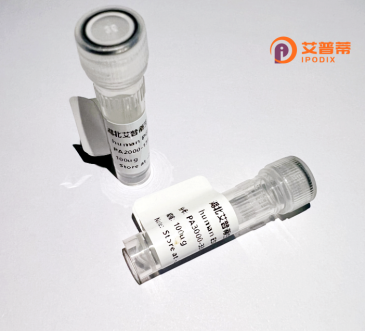
| 纯度 | >90%SDS-PAGE. |
| 种属 | Human |
| 靶点 | CGGBP1 |
| Uniprot No | Q9UFW8 |
| 内毒素 | < 0.01EU/μg |
| 表达宿主 | E.coli |
| 表达区间 | 1-167aa |
| 氨基酸序列 | MERFVVTAPP ARNRSKTALY VTPLDRVTEF GGELHEDGGK LFCTSCNVVL NHVRKSAISD HLKSKTHTKR KAEFEEQNVR KKQRPLTASL QCNSTAQTEK VSVIQDFVKM CLEANIPLEK ADHPAVRAFL SRHVKNGGSI PKSDQLRRAY LPDGYENENQ LLNSQDC |
| 分子量 | 45.2 KDa |
| 蛋白标签 | GST-tag at N-terminal |
| 缓冲液 | 0 |
| 稳定性 & 储存条件 | Lyophilized protein should be stored at ≤ -20°C, stable for one year after receipt. Reconstituted protein solution can be stored at 2-8°C for 2-7 days. Aliquots of reconstituted samples are stable at ≤ -20°C for 3 months. |
| 复溶 | Always centrifuge tubes before opening.Do not mix by vortex or pipetting. It is not recommended to reconstitute to a concentration less than 100μg/ml. Dissolve the lyophilized protein in distilled water. Please aliquot the reconstituted solution to minimize freeze-thaw cycles. |
以下是关于重组人CAG三联重复结合蛋白1(CGGBP1)的3篇典型文献,按研究主题整理:
-----
1. **文献名称**:*"CGGBP1 regulates CTCF binding at repeats and retrotransposons via modulation of DNA methylation and histone acetylation"*
**作者**:Asamizu S, et al. (2015)
**摘要**:研究证明CGGBP1通过调控DNA甲基化和组蛋白乙酰化修饰,影响CTCF蛋白在重复序列和逆转录转座子区域的结合,进而参与染色质三维结构形成和基因表达调控。
2. **文献名称**:*"Cloning and characterization of a cDNA encoding a novel human protein that binds to the unstable CGG repeat region in FMR1 mRNA"*
**作者**:Garberg G, et al. (2003)
**摘要**:首次报道CGGBP1的cDNA克隆及功能,揭示其特异性结合脆性X智力障碍基因(FMR1)mRNA中CGG重复序列,可能参与RNA代谢与神经发育相关疾病的分子机制。
3. **文献名称**:*"CGGBP1 modulates chromatin structure and histone H3K9 acetylation through interaction with HDAC1"*
**作者**:Bhattacharyya S, et al. (2009)
**摘要**:阐明CGGBP1通过与组蛋白去乙酰化酶HDAC1相互作用,调节特定基因组区域的组蛋白H3K9乙酰化水平,影响染色质开放性及靶基因的转录活性。
-----
上述文献涵盖CGGBP1的DNA/RNA结合特性、表观遗传调控作用及疾病关联,反映其在基因组稳定性和基因表达中的多面性功能。如需具体DOI或期刊信息可补充说明。
**Background of Recombinant Human CAG Triplet Repeat-BG Binding Protein 1 (CGGBP1)**
CGGBP1. a ubiquitously expressed DNA-binding protein, was initially identified through its affinity for CAG triplet repeats, sequences linked to neurodegenerative disorders like Huntington’s disease. It plays multifaceted roles in transcriptional regulation, chromatin remodeling, and genome stability. Structurally, CGGBP1 contains conserved zinc finger motifs and an intrinsically disordered region, enabling dynamic interactions with DNA, histones, and proteins like CTCF or RNA polymerase II.
CGGBP1 regulates gene expression by modulating chromatin accessibility, influencing the transcription of repeat-containing genes and repetitive elements, including satellite DNA. It also coordinates cellular stress responses, particularly during DNA damage or oxidative stress, by redistributing to nucleoli or stress granules. Dysregulation of CGGBP1 is implicated in repeat expansion disorders, cancer, and aging, with studies suggesting its involvement in maintaining heterochromatin integrity and suppressing genomic instability.
Recombinant CGGBP1. produced via bacterial or eukaryotic systems, facilitates in vitro studies of its binding dynamics and functional mechanisms. Despite progress, its exact regulatory networks and pathological contributions remain under investigation, highlighting its potential as a therapeutic target for repeat-associated diseases and epigenetics-driven conditions.
×